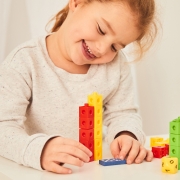Unleashing Mathematical Potential The Magic of Learning Math Through Play
Have you ever had the pleasure of observing the incredible impact that educational toys can have on children’s learning journeys. Among these, linking cubes, math cubes, and transparent number sets emerge as indispensable tools for not only making math understandable but also enjoyable for young learners. Let’s discuss the importance of incorporating play into math education and offer parents ten dynamic activities they can explore at home to infuse mathematics with excitement and engagement.
Mathematics often carries a reputation for being daunting or dull, but it doesn’t have to be that way. By infusing play into math learning, children can grasp mathematical concepts with greater depth while nurturing their creativity and problem-solving abilities. Linking cubes, math cubes, and transparent number sets provide tactile experiences that stimulate multiple senses, transforming abstract mathematical ideas into tangible, hands-on experiences.
Here are ten engaging activities for parents to try at home, each designed to foster math learning through playful exploration:
- Tower of Counting: Utilize linking cubes to construct towers of varying heights. Encourage your child to count the cubes as they stack them, reinforcing counting skills while also exploring concepts of magnitude and quantity.
- Pattern Parade: Create vibrant patterns using different coloured cubes or numbers from the transparent number set. Encourage your child to continue the pattern, honing their ability to recognize and extend sequences.
- Shape Sort-Out: Dive into a shape-sorting activity using the geometric shapes available in the math cube set. Challenge your child to categorize shapes based on attributes such as colour, number of sides, or size.
- Number Line Adventure: Lay out the transparent number set sequentially to form a dynamic number line. Practice counting forwards and backwards, as well as identifying numbers that precede or succeed a given number.
- Tower Math: Demonstrate addition and subtraction concepts visually using linking cubes. Build two towers representing different numbers, then combine or remove cubes to illustrate addition and subtraction operations.
- Measurement Exploration: Introduce measurement concepts by using linking cubes as units. Explore dimensions like length, width, and height by measuring objects around the house, comparing their sizes, and arranging them from smallest to largest.
- Fraction Fiesta: Employ math cubes to showcase fractions by partitioning them into equal parts. Experiment with different configurations to represent halves, thirds, quarters, and beyond, reinforcing the concept of fractions as parts of a whole.
- Dice Diversions: Spice up dice games with the transparent number set to practice addition, subtraction, multiplication, and division. Roll the dice and challenge your child to perform the corresponding mathematical operation.
- Shape Shaping: Foster creativity and spatial reasoning by using linking cubes to build diverse shapes and structures. Task your child with replicating specific shapes or designs, or let their imagination soar.
- Word Problem Puzzles: Craft simple word problems tied to everyday scenarios and use linking cubes or math cubes to visually depict the scenario. Empower your child to manipulate the cubes to solve the problem, bridging the gap between abstract math concepts and real-world applications.
By integrating these activities into your child’s routine, you can cultivate a positive attitude towards mathematics and nurture a lifelong passion for learning. Remember, the key is to keep it playful, interactive, and hands-on. With the right tools and approach, math learning becomes an exhilarating journey filled with discovery and joy. So, grab those linking cubes, math cubes, and transparent number sets, and embark on an adventure where math is not just learned but lived!


 Edx Education
Edx Education  Edx Education
Edx Education  Edx Education
Edx Education  Edx Education
Edx Education 
 edx education
edx education 
